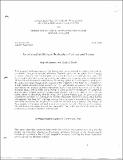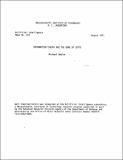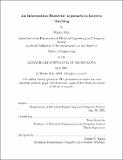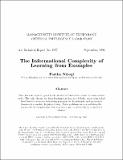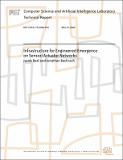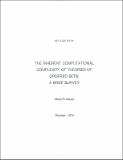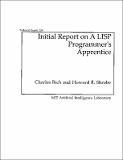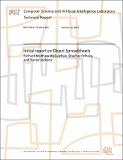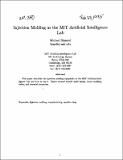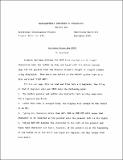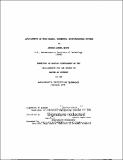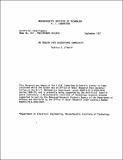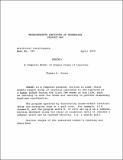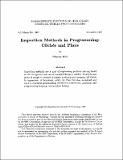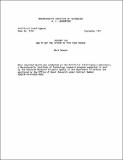Browsing Computer Science and Artificial Intelligence Lab (CSAIL) by Title
Now showing items 1646-1665 of 3804
-
An Information Storage Mechanism: Calcium and Spines
(1984-04-01)This proposal addresses some of the biophysical events possibly underlying fast activity-dependent changes in synaptic efficiency. Dendritic spines in the cortex have attracted increased attention over the last years ... -
An Information Theoretic Approach for Shared Bottleneck Inference Based on End-to-end Measurements
(2000-03)Recent years have marked a growing interest in studying Internet path characteristics. However, most of the currently available tools to an end system to perform such measurements are slow inaccurate and generate an excessive ... -
Information Theory and the Game of JOTTO
(1971-08-01)The word game, JOTTO, has attracted the interest of several computer programmers over the years, not to mention countless devoted players. Rules are: 1.) Each of 2 players selects a 5-letter English word, or a proper noun, ... -
An Information-Theoretic Approach to Interest Making
(2001-05)The Internet has brought a new meaning to the term communities. Geography is no longer a barrier to international communications. However, the paradigm of meeting new interesting people remains entrenched in traditional ... -
An Information-theoretical Approach to Studying Phoneme Collocational Constrainst
(1991-07)This thesis describe a lexical study of phoneme collocational constraints using a metric motivated by information theory. Phonologists have been describing the permissible combination of phonemes in the form of phonotactic ... -
The Informational Complexity of Learning from Examples
(1996-09-01)This thesis attempts to quantify the amount of information needed to learn certain tasks. The tasks chosen vary from learning functions in a Sobolev space using radial basis function networks to learning grammars in ... -
Infrastructure for Engineered Emergence on Sensor/Actuator Networks
(2006-03)The ability to control emergent phenomena depends on decomposingthem into aspects susceptible to independent engineering. Forspatial self-managing systems, the amorphous-medium abstraction lets youseparate the systemÂ’s ... -
Initial Report on a LISP Programmer's Apprentice
(1976-12-01)This is an initial report on the design and partial implementation of a LISP programmers apprentice, an interactive programming system to be used by an expert programmer in the design, coding, and maintenance of large, ... -
Initial report on Object Spreadsheets
(2016-01-12)There is a growing demand for data-driven web applications that help automate organizational and business processes of low to medium complexity by letting users view and update structured data in controlled ways. We present ... -
Injection Molding at the MIT Artificial Intelligence Lab
(MIT Artificial Intelligence Laboratory, 1995-02-23)This paper describes the injection molding equipment at the MIT Artificial Intelligence Lab and how to use it. Topic covered include mold design, insert molding, safety, and material properties. -
An Input Macro for TECO
(1966-09-01)A macro has been written for TECO that enables one to insert characters into the buffer as they are typed with the entire current page (if not greater than the display screen"s height in length) always being displayed. ... -
An Input/Output Architecture for Virtual Memory Computer Systems
(1974-01)In many large systems today, input/output is not performed directly by the user, but is done interpretively by the system for him, which causes additional overhead and also restricts the user to whatever algorithms the ... -
Input/Output in Time-shared, Segmented, Multiprocessor Systems
(1966-06)After introducing and defining the concepts of time-sharing, segmentation, and multiprocessing, two classes of systems incorporating these are introduced. Both classes use associative memories, as 'look behind' devices ... -
An Inquiry into Algorithmic Complexity
(1971-09-01)This is the first section in a proposed monograph on algorithmic complexity theory. Future sections shall include: information Theory as a Proof Technique; Algorithms Using Linear Form Inequalities; Some Probabilistic ... -
INSIM1: A Computer Model of Simple Forms of Learning
(1970-04-01)INSIM1 is a computer program, written in LISP, which models simple forms of learning analogues to the learning of a human infant during the first few weeks of his life, such as learning to suck the thumb and learning ... -
Inspection Methods in Programming
(1981-06-01)The work reported here lies in the area of overlap between artificial intelligence software engineering. As research in artificial intelligence, it is a step towards a model of problem solving in the domain of ... -
Inspection Methods in Programming: Cliches and Plans
(1987-12-01)Inspection methods are a kind of engineering problem solving based on the recognition and use of standard forms or cliches. Examples are given of program analysis, program synthesis and program validation by inspection. ... -
Instant TJ6. How to Get the System to Type Your Papers
(1971-09-01)TJ6 is a program that takes disk files of text and arranges them so that they can be printed out neatly on 8 1/2 by 11 paper, lines justified, pages numbered, and so on. So that TJ6 will know what to do you must insert ...

